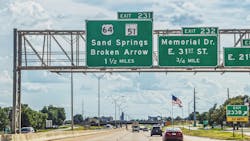ODOT Slashes and Delays Dozens of State Road Projects Due to Budget Constraints
Key Takeaways
• The Oklahoma Department of Transportation (ODOT) has reduced and delayed dozens of projects in its updated 2026–2033 Eight-Year Construction Work Plan due to rising road construction costs and federal funding uncertainty.
• Construction costs have surged 63% since 2020, compressing nearly two decades of inflation into three years, according to ODOT Director Tim Gatz.
• Despite cuts, the plan still includes over 1,200 highway and bridge projects valued at $7.7 billion, with funding from state, federal, and bond sources.
The Oklahoma Department of Transportation released an updated Eight-Year Construction Work Plan that includes cuts and delays to dozens of state road and bridge projects as the agency faces significant budget constraints.
The reductions stem from rising road construction and materials costs and uncertainty surrounding future federal infrastructure funding, according to Oklahoma News 4.
Despite the challenges, the Fiscal Year 2026–2033 plan still outlines more than 1,200 transportation infrastructure projects valued at $7.7 billion, Fox 23 News reported.
ODOT Director Tim Gatz said during an Oct. 6 meeting that road construction costs have increased 63 percent since 2020, Oklahoma News 4 reported, noting that the department is facing 18 years of inflation compressed into just three, according to Fox 23 News.
Considering these constraints, ODOT can now complete fewer projects with its existing budget.
Road Construction Funding Sources: Federal and State Strain
ODOT heavily relies on federal highway funding for road projects, which accounts for 60 percent of its budget. A large portion comes from the 2021 federal infrastructure bill, but that allocation is set to expire and Congress has yet to approve a renewal, Oklahoma News 4 reported.
The remaining 40 percent comes from state funding sources, including:
- A 19 – cent gas tax that hasn’t been updated since 1990 (10 percent of total budget).
- A mix of state income taxes, registration fees and legislative appropriations (20 percent).
With both federal and state sources under pressure, ODOT faces mounting financial challenges to sustain its road and bridge improvement programs.
Major Oklahoma Highway and Bridge Projects Facing Delays
While the agency’s revised plan removes and postpones dozens of road construction projects, some high-profile projects are among those affected, according to Oklahoma News 4. These include:
- Interchange rebuild at Interstate-44, Lake Hefner Parkway (OK-74) and OK-66.
- Improvements to I-44 between Lake Hefner Parkway and Interstate-235.
- Rebuild on Interstate-35 between Interstate-40 and I-44 in Oklahoma City and 2nd Street to the Logan County border in Edmond.
Despite the cuts, Gatz emphasized that these projects remain a priority but will take longer to complete due to financial constraints, according to Oklahoma News 4.
Remaining Projects in ODOT’s 2026–2033 Construction Plan
According to Fox 23 News, the revised Eight-Year Construction Work Plan still includes:
- 675 miles of rural highway improvements.
- 2,810 lane-miles of pavement upgrades.
- 209 at-risk bridges.
- 12 structurally deficient bridges.
Additionally, ODOT also plans to leverage bond funding to fast-track critical infrastructure projects including:
- US-70 Roosevelt Bridge.
- US-81 Chickasha Bypass.
- Phases of Interstate-35 widening from Oklahoma City to Texas.
These efforts aim to keep essential roadwork moving forward while managing limited resources.
ODOT’s Plan to Mitigate Delays and Preserve Road Safety
In response to funding challenges, ODOT introduced a Four-Year Asset Preservation Plan focused on preventative maintenance to extend the lifespan of existing roads and protect driver safety.
To restore long-term funding levels, Gatz said federal and state legislative action will be required.
To keep infrastructure priorities on track amid rising costs and funding uncertainty, transportation agencies must lean into strategic planning, explore flexible financing, and advocate for sustained investment. Collaboration with lawmakers and a focus on long-term asset preservation will be key to maintaining safe, reliable roads nationwide.
Sources: Oklahoma News 4, Fox 23 News
